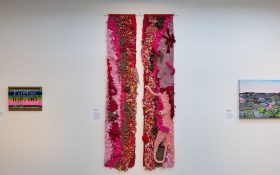Nathan Lay, Michael Lapina and Shakira Tsindos in Opera Australia’s 2018 Schools Tour production of By the Light of the Moon. Photo credit: Jeff Busby.
Last week, Big hART’s Scott Rankin argued in an ArtsHub opinion piece that the Major Performing Arts (MPA) Framework ‘does more harm than good‘. Here, the Chair, Deputy Chair and Executive Director of the Australian Major Performing Arts Group (AMPAG) respond.
* * *
Divide and conquer is a well proven destructive tactic. Now, more than ever, we in the arts need to work together to increase funding overall, not to fight amongst ourselves. Such division implies defeat – that funding for the arts should remain static. The message we should all be united in sending is that support for the arts needs to grow to better serve artists and audiences across the country. The success of the MPA framework should serve as evidence of this, giving cause to extending this practice – not destroying it.
The existing MPA framework was designed for a purpose: to build stability and continuity, enabling longer-term planning; to produce significant works of scale; to support advancement for the art form and the artist, and enrich lives through growing access for the community. The framework was reviewed in 2011 and changes were made to ensure it continued ‘…encouraging and rewarding artistic achievement and best practice governance and management’. It has clearly succeeded in delivering to this purpose on both a creative and financial basis for nearly 20 years.
AMPAG supports a review to ensure the objectives are still relevant, and that the MPA framework is the best way of achieving them.
The MPA companies are a significant and important part of the arts ecology – as major employers, major venue hirers and major producers of works of scale, including new and innovative works. They provide important scholarships, fellowships, mentorships and residencies. They collaborate with smaller arts organisations, contribute significantly to cultural diplomacy, and are long-term providers of arts education in schools and community engagement programs. Many MPAs manage significant performing arts venues, investing in their development to better serve artists, the art and the audience. They have deep, valued and growing connections with their often multi-generational audiences, here and abroad, and via digital platforms.
Each MPA organisation serves the fragile arts ecology in its own complex way. To underestimate the stabilty dividend generated through the MPA framework limits the conversation and risks ignoring strategic insights into how the MPA framework might be strengthened, and in turn, strengthen outcomes for the artforms, the artists and the audience.
It is easy, during evaluation opportunities such as this, to pit the MPA’s against the rest of the sector. Reducing the complexity of our sector to such black and white divisions carries danger and creates fractures within our own community, draining our energy and diluting the message that the sector requires greater investment. No matter what part of the arts sector we work in, we can all agree that to realise the potential of our sector, greater funding is required: from all levels of government and from corporate and philanthropic support. It is important to understand that governments provide the seed funding that builds the foundations of the company. That funding is leveraged by the MPA companies to the tune of $2.29 for each $1 of government funding.
The Australia Council for the Arts 2016-17 Annual Report notes ’The major performing arts (MPA) sector is an integral part of the arts in Australia. They are leading companies in the fields of dance, theatre, circus, opera and orchestral and chamber music. The MPA companies support the careers of Australian performing artists and creatives, bring works of scale to Australian and international audiences, and are critical to some of Australia’s most iconic venues, festivals and other arts infrastructure.’
The role of the small to medium arts organisations and the work they do is no less valuable. It is an incredibly important, fertile and creative hothouse for new works and ideas.
The annual report states further, ‘The hundreds of organisations in the small to medium arts sector occupy the significant territory between individual arts practitioners and larger scale companies. They play a critical role in the Australian arts landscape, and can be viewed as a leading “public activator” of Australia’s arts and cultural life. Their work embraces and engages local artists, and is collaborative and highly accessible to national and international audiences. The small to medium arts sector is responsive and exceptionally diverse, providing an environment for creative risk, innovation and experimentation, and a platform for new and emerging work.’
There is a need to grow revenue for the sector as a whole, and the needs of the non-MPA sector are particularly evident. Building sustainability for independent arts practice and continuity for small to medium performing arts organisations, as the framework has done for the MPA sector, would unlock further cultural value for Australian communities.
The MPA framework has within it significant responsibilities, rigorous reporting and considered pathways to enter and exit. AMPAG absolutely agrees that the framework can be strengthened, its membership expanded, priorites adjusted, and the wellbeing of the whole sector improved as a result. The MPA companies support elite artists and creators, but are not elitist. They represent the dream for many young creatives, whether singers, actors, musicians, dancers or any one of hundreds of creative roles in the performing arts. We support the current review aimed at strengthening the framework, and encourage readers to complete the survey. We are and always will be open to new ideas and new members.
The MPA companies support the evolution of the current framework, believing that the way forward is to stay the course, but not stay the same.
The Federal Government’s survey about the MPA Framework closes on 9 August 2018. Have your say at www.arts.gov.au.





